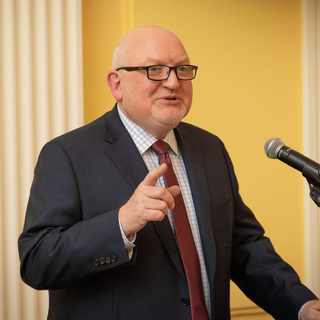Professor Martin Jean on the ISM's 50 years at Yale

If you look at the Institute of Sacred Music indentures without doing the necessary textual and historical criticism, you might think to yourself, “What a noble idea… . and… . how in the world is this ever going to work?” It’s true that in these beautiful texts, one catches a clear sense of the vision for the ISM. One also gets the sense that a grand experiment was embarking with an enormous vote of confidence in Yale to launch it. From my perspective, and fifty years later, that vote of faith was well founded. In my opinion, the ISM works, and we have fifty classes of brilliant alums to prove it!
The idea for the Institute was not to make a school, but something that was school-like. It was also meant to be more than a “center”, because centers don’t typically have faculty and students. In fact, we are too small to be a school at Yale, and it’s quite clear that the donors wanted the work of the ISM to extend far beyond its own four walls. The ISM was meant to have its own unique mission, voice and culture, its own means of volition, its own ability to be nimble and innovative. It was also equipped with a strong set of checks and balances to ensure quality control as well as integration of its mission into the Schools of Music and Divinity, and, indeed, the entire university. In founding the ISM here at Yale, the university made a clear commitment to the values and blessings that interdisciplinary research, pedagogy and practice in sacred music, worship, and the related arts provide.
I love this particular thought from our donors’ letter of intent:
“A peculiar danger of our own society is that so many of us are now so well off. The “do-it-yourself” society is in danger of developing a contempt for the minority of poor, and disadvantaged, and helpless. In recalling us to such concern and to the unpalatable truth that we save our lives only by losing them, the compassionate artist has often been the best preacher among us.”
That paragraph alone gives you a bit of the sense of why it was created.
But given that it exists, and given our claim that it works, why does this work?
That’s easy! It works because of the lavish support we receive from every corner. It works because this Institute has been cared for and governed by inspiring university officers who get it.
It works because this director has been staunchly supported by a wise and resourceful vice provost who gets it (Emily Bakemeier: ally, advocate, therapist, fellow strategist, supreme diplomat, and friend. And many directors and vice provosts before her.)
It works because of the indelible alliances with deans of our sibling schools who get it.
It works because of amazingly talented faculty, students, staff, and alums who get it.
It works because of a donor family who follows us closely and gets it.
But what is “it”? What is the essence of the thing that is being cared for?
Well, perhaps “it” is something like this:
That people and communities as long as anyone can remember, have looked within themselves and without and perceived something more: something indefinable, but larger than they. Something that creates and culminates. Something that inspires and convicts. Something that brings meaning and purpose to living. Something that binds communities together. Something that helps them understand the world in which they live. There are too many names for this for the time we have: God? The sacred? The Divine? The numinous? Maybe not everyone claims they do this, but there are billions who do and countless more who have done so for a very, very long time.
Well, these people and communities, in turn, create in response to that perception, or perhaps because of it. They build structures, they form ethical systems, they make sounds and music, they create images and objects, they incant, they intone, they gesture, they dance, they pray! Sadly, they also sometimes make war.
And because this drive and these things are all indelibly linked – to the extent that you can’t get your arms around one without the other – there needs to be a place that pulls together the smartest minds, the best artists, the wisest leaders that can foster understanding, critique, reinterpretation, and new practices; that preserves the best of the past and innovates into the new, and celebrates the whole thing while doing it.
Maybe that’s the “it.” And for my part, I don’t know a time in history when “it” has been more needed. I give thanks for this Institute, and I give thanks for those founders who conceived of the idea to begin with. And I give thanks for generations of brilliant staff, faculty, students, alums, and supporters who have loved us into what we are today – fifty years later.
Here’s to the next fifty.